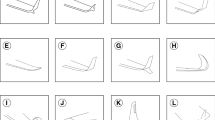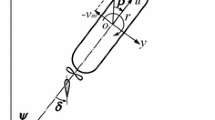Abstract
Hybrid-driven technology, which can improve the sailing performance of underwater gliders (UGs), has been successfully used in ocean observation. However, a hybrid-driven UG (HUG) with an added tail propeller is still unable to achieve backward and turning motion with a body length radius, and the hydrodynamic pitch moment acting on the HUG that is mainly caused by the fixed-wing makes it difficult to achieve high-precision attitude control during fixed-depth navigation. To solve this problem, a two-degree-of-freedom bioinspired controllable wing mechanism (CWM) is proposed to improve the maneuverability and cruising ability of HUGs. The CWM can realize five motion modes: modifying the dihedral angle or anhedral angle, changing the frontal area of the wing, switching the wing from horizontal to be a vertical rudder, flapping the wing as propulsion, and rotating the wing as a vector propeller. First, the design process of the CWM is provided, and hydrodynamic forces in each motion mode of three CWMs with different trailing edge sweepback angles (TESA) and attitude angles are analyzed through computational fluid dynamics simulation. The relationship between hydrodynamics and the attitude angles or TESA of the CWM is analyzed. Then, experiments are conducted to measure the hydrodynamics of the CWM when it is in a flapping wing mode and rotating the wing as a vector propeller, respectively. The hydrodynamic forces obtained from the simulation are consistent with data measured by a force sensor, proving the credibility of the simulated hydrodynamics. Subsequently, by applying the results of the hydrodynamic force in this study, the flapping trajectory of the wingtip is planned using the cubic spline interpolation method. Furthermore, two underwater demo vehicles with a pair of CWMs are developed, and experiments are conducted in a water tank, further validating and demonstrating the feasibility of the proposed CWM.
Similar content being viewed by others
References
Eriksen C C, Osse T J, Light R D, et al. Seaglider: A long-range autonomous underwater vehicle for oceanographic research. IEEE J Ocean Eng, 2001, 26: 424–436
Webb D C, Simonetti P J, Jones C P. SLOCUM: An underwater glider propelled by environmental energy. IEEE J Ocean Eng, 2001, 26: 447–452
Sherman J, Davis R E, Owens W B, et al. The autonomous underwater glider “Spray”. IEEE J Ocean Eng, 2001, 26: 437–446
David M. Glider technology for ocean observations: A review. Ocean Science, 2016, 6: 1–26
Rudnick D L, Davis R E, Eriksen C C, et al. Underwater gliders for ocean research. Mar Technol Soc J, 2004, 38: 73–84
Yang Y, Liu Y, Wang Y, et al. Dynamic modeling and motion control strategy for deep-sea hybrid-driven underwater gliders considering hull deformation and seawater density variation. Ocean Eng, 2017, 143: 66–78
Wood S, Allen T, Kuhn S, et al. The development of an autonomous underwater powered glider for deep-sea biological, chemical and physical oceanography. In: Oceans 2007 Europe International Conference. Aberdeen, 2007. 151–156
Fang L, Wang Y, Wang S. Development of the hybrid underwater glider petrel-II. Sea Technol, 2014, 55: 51–54
Alvarez A, Caffaz A, Caiti A, et al. Fòlaga: A low-cost autonomous underwater vehicle combining glider and AUV capabilities. Ocean Eng, 2009, 36: 24–38
Dong H, Wu Z, Tan M, et al. Hydrodynamic analysis and verification of an innovative whale shark-like underwater glider. J Bionic Eng, 2019, 17: 123–133
Croll D A, Acevedo-Gutiérrez A, Tershy B R, et al. The diving behavior of blue and fin whales: Is dive duration shorter than expected based on oxygen stores? Compar Biochem Phys Part A Mole Integ Phys, 2001, 129: 797–809
Sudki B, Lauria M, Noca F. Robotic penguin-like propulsor with novel spherical joint. In: 66th Annual Meeting of the APS Division of Fluid Dynamics. Australia, 2013. 23–30
Wu Z, Yu J, Yuan J, et al. Towards a gliding robotic dolphin: Design, modeling, and experiments. IEEE/ASME Trans Mechatron, 2019, 24: 260–270
Song S H, Kim M S, Rodrigue H, et al. Turtle mimetic soft robot with two swimming gaits. Bioinspir Biomim, 2016, 11: 36–52
Hu H, Li X K, Wang X D, et al. Study on the effect of winglet installation angle in vortex characteristics of separation vortex. J Eng Therm Energ Power, 2016, 31: 45–52
Neilson J L, Straley J M, Gabriele C M, et al. Non-lethal entanglement of humpback whales (Megaptera novaeangliae) in fishing gear in northern Southeast Alaska. J Biogeography, 2010, 36: 452–464
Kosma M M, Werth A J, Szabo A R, et al. Pectoral herding: an innovative tactic for humpback whale foraging. Royal Soc Open Science, 2019, 6: 1–13
Shi W, Atlar M, Norman R. Detailed flow measurement of the field around tidal turbines with and without biomimetic leading-edge tubercles. Renew Energy, 2017, 111: 688–707
Shi W, Atlar M, Norman R. Learning from humpback whales for improving the energy capturing performance of tidal turbine blades. Trends Challeng in Marit Energ Manag, 2018, 6: 479–497
Shi W, Atlar M, Rosli R, et al. Cavitation observations and noise measurements of horizontal axis tidal turbines with biomimetic blade leading-edge designs. Ocean Eng, 2016, 121: 143–155
Shi W, Rosli R, Atlar M, et al. Hydrodynamic performance evaluation of a tidal turbine with leading-edge tubercles. Ocean Eng, 2016, 117: 246–253
Wagner A, Richter K K, Ludes E, et al. Whale bone puzzles: Reconstructing and identifying historical whale skeletons using archive records, osteology, and zooarchaeology by mass spectrometry (ZooMS). J Conserv Museum Stud, 2020, 18: 1–8
Tian W L. Motion characteristic analysis of a hybrid-driven underwater glider with independently controllable wings (in Chinese). J Northwestern Polytech Univ, 2013, 31: 122–128
Xie Y, Yang C, Wang P, et al. Improved performance of an underwater glider with passively rotatable wings. In: MTS/IEEE Oceans Conference. San Diego, IEEE, 2013. 1–5
Arima M, Ichihashi N, Ikebuchi T. Motion characteristics of an underwater glider with independently controllable main wings. In: International Conference OCEANS 2008 and MTS/IEEE Kobe Techno-Ocean 2008. IEEE, 2008. 951–957
Arima M, Ichihashi N, Miwa Y. Modelling and motion simulation of an underwater glider with independently controllable main wings. In: OCEANS 2009-Europe. IEEE, 2009. 472–477
Isa K, Arshad M R. Neural network predictive control of propeller-driven underwater glider with controllable wings and rudder. Oceans, Waikoloa, 2012. 1–7
Yang Z, Wang Y, Wu Z, et al. Mechanism design of controllable wings for autonomous underwater gliders. In: OCEANS 2014-Taipei. IEEE, 2014. 1–5
Sun T S, Yang M Y, Wang Y H, et al. Parametric design and experimental verification of cicada-wing-inspired controllable wing mechanism for underwater glider. In: IFToMM Word Congress on Mechanism and Machine Science. Poalnd, 2019. 23–32
Andeen, Gerry B. Robot Design Handbook. McGraw-Hill, 1988. 23–78
Angeles J. Fundamentals of Robotic Mechanical Systems. Springer, 2003. 5–120
Piazzi A, Visioli A. Global minimum-jerk trajectory planning of robot manipulators. IEEE Trans Ind Electron, 2000, 47: 140–149
Zhang X J, Gao X H. The research on the cubic splines in robot’s trajectory planning (in Chinese). Mach Design Manuf, 2008, 3: 170–173
Tang S J, Liu Z C, Zhou Y Q, et al. Investigation on aerodynamic performance of tandem wing UAV with rear wing dihedral (in Chinese). J Beijing Inst Technol, 2015, 35: 1211–1216
Hareesha N G, Reddy S, Tanzeel A. Dihedral and anhedral convertible wing mechanism for UAV. J Emerg Technol Innov Res, 2020, 7: 87–92
Niu W, Wang S, Wang Y, et al. Stability analysis of hybrid-driven underwater glider. China Ocean Eng, 2017, 31: 528–538
Zheng Y, Wu Y, Tang H. A time-resolved PIV study on the force dynamics of flexible tandem wings in hovering flight. J Fluid Struct, 2016, 62: 65–85
Author information
Authors and Affiliations
Corresponding author
Additional information
This work was supported by the National Key R&D Program of China (Grant No. 2016YFC0301101), the National Natural Science Foundation of China (Grant No. 51721003), the Natural Science Foundation of Tianjin City (Grant No. 18JCJQJC46400), and the Aoshan Talent Cultivation Program of QNLM (Grant Nos. 2017ASTCP-OS05 and 2017ASTCP-OE01).
Rights and permissions
About this article
Cite this article
Sun, T., Wang, Y., Yang, S. et al. Design, hydrodynamic analysis, and testing of a bioinspired controllable wing mechanism with multi-locomotion modes for hybrid-driven underwater gliders. Sci. China Technol. Sci. 64, 2688–2708 (2021). https://doi.org/10.1007/s11431-021-1890-7
Received:
Accepted:
Published:
Issue Date:
DOI: https://doi.org/10.1007/s11431-021-1890-7




